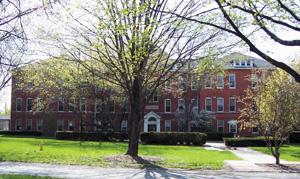
By Barb Arland-Fye
The Diocese of Davenport filed its 2010 report in U.S. Bankruptcy Court on May 3, outlining diocesan compliance with the non-monetary undertakings of its bankruptcy settlement. As part of the $37 million settlement reached in May 2008 with survivors of clergy sexual abuse, the diocese and Catholic entities were required to submit a report in each of the three years following the settlement about non-monetary commitments.
Here are answers to questions The Catholic Messenger asked concerning this year’s report:
• What changes have been made in the past year concerning the nonmonetary agreement?There are none, said Rand Wonio, an attorney with Lane & Waterman LLP, which represents the Davenport Diocese. “Both sides were told by the judge to clarify some issues (concerning the 2009 report) and that process is ongoing.” Among the issues needing clarification is the posting of the names of all clergy credibly accused of sexual abuse of a minor — living and dead. Disagreement exists over the use of the term “credible.”
• How many new accusations of sexual abuse of a minor by clergy have been made in the past year?
No new reports of abuse have been submitted since the last report, Wonio said. One investigation has been reopened, at the request of a survivor concerning a deceased priest. The Diocesan Review Board and James Sweeney, a special investigator appointed by the bankruptcy court, are investing the matter, according to the 2010 bankruptcy report.
• What is the status of the atonement services, which Bishop Martin Amos agreed to lead at each parish where abuse occurred or where the perpetrator served?
Bishop Amos conducted 54 parish atonement services, completing that commitment on June 13, 2009, the court document states.
• What is the bishop’s next step in demonstrating his support for complete elimination of all criminal statutes of limitation for child sexual abuse committed by clergy or others in a position of authority?
In October 2009, at the fall meeting of the Iowa Catholic Conference (ICC), Bishop Amos urged support for enactment of a bill to eliminate the criminal statute of limitations for child sexual abuse. He did so again on Feb. 2, 2010, at an ICC-hosted event at the State Capitol while talking with Iowa legislators. “I hope it becomes one of the priorities on the Iowa Catholic Conference’s list of legislative priorities for next year’s Iowa Assembly,” Bishop Amos told The Catholic Messenger on May 4.
• Have any claimants (other than persons with convenience claims) asked to speak publicly in the parish where he or she was abused?
No new requests have been received since the last report.
• Have any survivors asked to speak with the bishop since the last report?
Yes. One woman shared her story with Bishop Amos, and he said he was moved by it. “It certainly affected me and I certainly hope it brought some healing to her,” he said.
• How many letters of apology have been requested of Bishop Amos since the last report?The bishop personally sent two additional letters of apology to survivors as requested, according to the court document. The letters of apology state that the survivor was not at fault for the abuse and that the diocese takes full responsibility for the abuse. The letters are personally signed by the bishop and all members of the Diocese’s Board of Directors.
• How does the Diocesan Review Board determine whether an accusation against a clergy member is credible or not?
“They look at all accusations on a case-by-case basis,” Wonio said. In the bankruptcy case, “James Sweeney performed thorough investigations … including looking for corroborating witnesses. Depositions and medical records were looked at, whenever they were available, on these claims. It was a very exhaustive process.” A greater preponderance of evidence is required in determining credible allegations against deceased clergymen because they are unable to defend themselves, Wonio noted.
• Who are the members of the Diocesan Review Board?
Clarence Darrow, a lawyer, retired judge and former Illinois legislator who also worked as a child abuse investigator/court liaison; Catherine Fouts, past president of the Diocesan Board of Education and past vice president of the Newton Community School District Board of Education; Bernard Hardiek, retired past-president of Deere & Company Worldwide Agricultural Equipment Division; Msgr. James Parizek, Promoter of Justice for the diocese and pastor of Our Lady of Victory Parish in Davenport; Chris McCormick Pries, ARNP, associate director for research, evaluation and community relations with Vera French Community Mental Health Center in Davenport; and Father Tony Herold, pastor of Jesus Christ, Prince of Peace Parish in Clinton and dean of the Clinton Deanery. Ex officio members are Bishop Martin Amos and Msgr. John Hyland, vicar general.
• How does this report address concerns about adequate counseling for a survivor who received a settlement and testified at the court hearing last October?
His testimony was not a part of the report. The diocese, however, has been paying for his counseling ever since, Wonio said.
• How much has the diocese spent in counseling fees for survivors since the last report?
For the fiscal year to date, the diocese has spent $47,867, said Char Maaske, the diocese’s chief financial officer.
• Have all survivors received their financial settlements?
That information has not been shared with the diocese, Wonio said.
• How many people have received training on child protection efforts in the diocese and how much has the diocese spent in efforts to protect children?
For the fiscal year ending June 30, 2009, 17,489 individuals had been trained in safe environment programs for protection of children, Maaske said. Nearly 14,000 of those individuals were children. The diocese spent $22,133 for all child protection efforts for calendar year 2009.
• When will the diocese complete its obligation to submit an annual report to the bankruptcy court?It should be next year. It was a three-year obligation, Wonio said.








